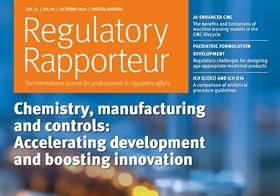
Regulatory Rapporteur
October 2024 | Volume 21 | No.9
In this month’s issue of Regulatory Rapporteur, we focus on chemistry, manufacturing and controls (CMC). The role of CMC is essential in ensuring drug quality and effectiveness throughout the product development lifecycle and is the area where technical and regulatory expertise meet.

Throughout the pharmaceutical CMC development process, the importance of regulatory compliance is crucial, from the strategic development phase through to formulation and analytical development, supplies for clinical trials and commercial manufacture. The articles in this issue illustrate how CMC development can be expedited in different ways, be that through increasingly robust guidance on analytical procedures, more focused consideration of market needs early in the development lifecycle or by using AI to help elevate efficiency, drive regulatory readiness and enhance innovation.
Our first article by Mariam Amer, Eric Kelly, George Oliarnyk and Tiejun Wang focuses on the rapidly emerging area of artificial intelligence and its use in the CMC space. AI is fast becoming part of our digital world and we are seeing the start of proactive adoption in the pharmaceutical industry with initiatives at the US Food and Drug Administration (FDA) and the European Medicines Agency (EMA) alongside increased collaboration with industry. In the CMC field, AI can bring efficiency and increased compliance with large language models being used to author dossiers and machine-based learning reducing the time needed to write and find data. Using AI to generate CMC content frees up regulatory professionals to focus on reviewing and improving content and adding strategic input.
Our second article by Francisco Baptista, Julien Douillet and Imke Veltman evaluates the challenges of developing an age-appropriate paediatric formulation and the complex regulatory framework covering dosage forms, excipient selection and patient acceptability. It reviews the history of the EU and US regulations, the CMC guidance, product development and the importance of engagement with the health authorities early on in the development process.
Our final focus article by Rajendra Kunda, Slobodanka Cirin-Varadjan, Rick Best, Hao Liu and Srinivas Yerraguntla gives a comparison between ICH Q2(R2), the guideline for validation of analytical methods, and the newly adopted ICH Q14, which concentrates on analytical method development. ICH Q2(R2) is well established with a traditional and precise framework for method validation and ICH Q14 covers the entire lifecycle of analytical procedures with a focus on Quality by Design and risk management. This article explores how the guidelines work together and how ICH Q14 enhances the robustness and reliability of analytical procedures.
We then move into regulatory operations and the introduction of the digital application dataset integration (DADI), which is the first step in the identification of medicinal products (IDMP) implementation. Our article by Kirti Yadav, Anamika Goel, Javier Benito, Surabhi Parasher, Vivek Tomar and Allison Gillespie provides an overview and roadmap of the move to DADI and the replacement of the current PDF web-based application form. It also evaluates the benefits and the challenges of this change.
Our final article by Penny Field looks at small interfering RNA (siRNA). We are now seeing therapeutics based on this approach appearing on the pharmaceutical market for a wide range of therapeutic areas in rare genetic diseases. This article looks at the history, manufacturing, drug delivery and mode of action.
































